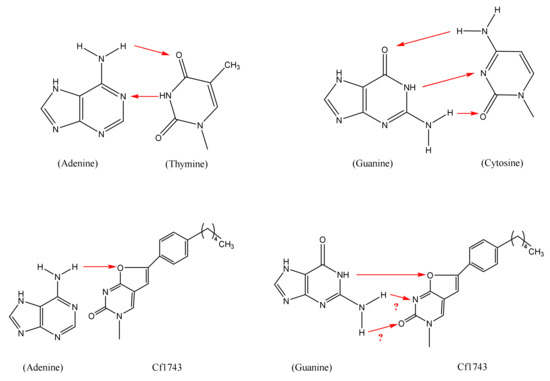Abstract
The bicyclic nucleoside analogue (BCNA) Cf1743 and its orally bioavailable prodrug FV-100 have unique potential as varicella-zoster virus (VZV) inhibitors to treat herpes zoster (shingles) and the therewith associated pain, including post-herpetic neuralgia (PHN). The anti-VZV activity of Cf1743 depends on a specific phosphorylation by the VZV-encoded thymidine kinase (TK). The target of antiviral action is assumed to be the viral DNA polymerase (or DNA synthesis in the virus-infected cells).
1. Introduction
In 2010, Marco Migliore stated in Antiviral Chemistry and Chemotherapy that FV-100, the hydrochloride (named hydrochloric) salt of the 5′-valyl ester of Cf1743, was the most potent and selective anti-varicella-zoster virus (VZV) agent reported to date [1]. As of today, in 2022, this statement still holds true. The bicyclic furo [2,3-d] pyrimidine nucleoside analogue (BCNA) Cf1743 and its 5′-valyl ester FV-100 have been the subject of a number of review articles by myself [2,3,4,5,6,7] and my colleagues, Graciela Andrei and Robert Snoeck [8,9,10], and other authors [11,12,13], but neither Cf1743 nor FV-100 or any derivative thereof have so far been licensed for clinical use in the therapy of VZV infections, such as herpes zoster. Here, I will address the current state of the art of FV-100 and evaluate the issues that still remain to be resolved.
2. History
The original BCNAs were obtained as by-products in Pd-catalyzed coupling of terminal alkynes with 5-iodo-nucleoside analogues, resulting in the preparation of 5-alkynyl-2′-deoxyuridines starting from 5-iodo-2′-deoxyuridine [14]. BCNAs bearing an aryl side chain were then prepared [15], from which originated Cf1743 (Figure 1).
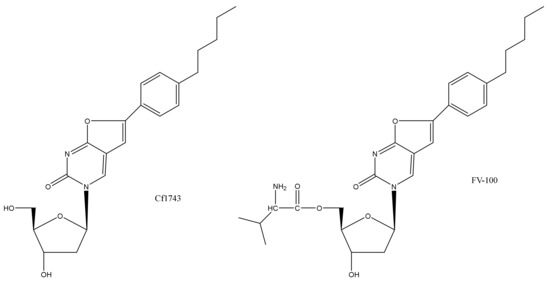
Figure 1.
Chemical structures of Cf1743 and FV-100.
3. Anti-VZV Activity
In human embryonic lung (HEL) fibroblast cell cultures, Cf1743 proved clearly more potent against a wide range of clinical VZV isolates and reference laboratory VZV strains than BVDU, acyclovir (ACV), penciclovir (PCV) and foscarnet (PFA) (Figure 2) [3,16]. Cf1743 was not active against ACV- and BVDU-resistant VZV strains bearing a mutation in the viral thymidine kinase gene but kept their inhibitory potential against VZV strains with mutations in the VZV DNA polymerase gene [16]. Mutant virus strains selected in the presence of the BCNAs were solely cross-resistant to drugs such as ACV and BVDU that depend on metabolic activation by the viral thymidine kinase for their antiviral action [16].
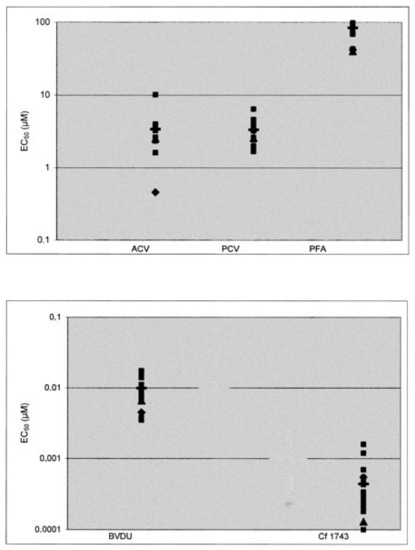
Figure 2.
Activity of CF1743 as compared to that of acyclovir (ACV), penciclovir (PCV) and foscarnet (phosphonoformic acid, PFA) and brivudine (BVDU) against clinical VZV isolates (■) and VZV reference strains Oka (▲) and YS (♦). Mean values for clinical isolates are indicated by horizontal lines (▬). Data taken from Refs. [3,16].
4. Metabolism (Anabolism, Catabolism)
The metabolism of the BCNAs, as exemplified for CF1743, is, as far as anabolism is concerned, mainly comparable to that of BVDU (Figure 3) in that it entirely depends on its successive phosphorylation to the 5′-monophosphate (BCNA-MP) and 5′-diphosphate (BCNA-DP). The latter is then assumed to be converted to the 5′-triphosphate (BCNA-TP) by a nucleoside diphosphate kinase (NDPK) [3]. The target for the antiviral action is postulated to be the viral and/or cellular DNA polymerase, but this has not been directly demonstrated.
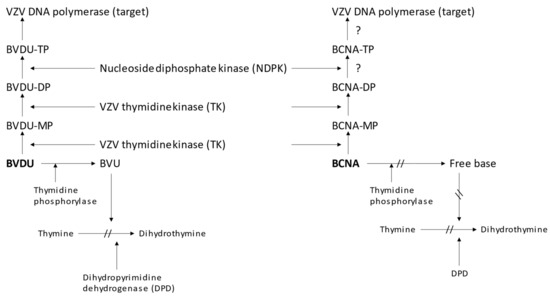
Figure 3.
Anabolic and catabolic steps involved in the metabolism of BVDU and BCNA.
While BVDU [(E)-5-(2-bromovinyl)-2′-deoxyuridine] (BVDU) is promptly recognized by thymidine phosphorylase to be converted to its free base [(E)-5-(2-bromovinyl)uracil] (BVU), this conversion does not occur with the BCNAs, i.e., Cf1743 [17]. Accordingly, BCNAs cannot give rise to the formation of any products that, like BVU, might inhibit the activity of dihydropyrimidine dehydrogenase (DPD), and, consequently, interfere with the degradation of pyrimidine analogues such as 5-fluorouracil (FU). Due to the increased plasma FU levels, the concomitant use of FU with the BVU generating anti-VZV compound (E)-5-(2-bromovinyl)-1-β-D-arabinosyluracil (BVaraU, sorivudine) has led to some casualties of Japanese patients [17]. This problem can obviously be averted by using BCNAs such as Cf1743 not interfering with FU metabolism.
In contrast with BVDU, which is specifically active against both herpes simplex virus type 1 (HSV-1) and VZV, the antiviral activity spectrum of CF1743 is confined to VZV. The VZV-encoded thymidine kinase (TK) [18] successively phosphorylates the BCNA Cf1743 to its 5′-mono- and 5′-diphosphate (Figure 3). What happens next in this process has not been elucidated. It is presumed that the BCNA-DP is subsequently converted to its 3′-triphosphate (BCNA-TP) by a nucleoside diphosphate kinase (NDPK). The BCNA-TP is assumed to be the active metabolite of CF1743, interacting with the viral DNA synthesis (or DNA synthesis within VZV-infected cells).
6. Switch from Cf1743 to FV-100
Cf1743 was found to exhibit poor oral bioavailability (~14%) [19]; therefore, its 5′-valyl ester was designed, which as its HCI salt emerged as the most promising prodrug of CF1743 and was designated as FV-100. There was a significant (~10-fold) boost in both AUC and Cmax for FV-100 over Cf1743 (Figure 5) [1]. Accordingly, FV-100 was chosen as the clinical BCNA candidate for the treatment of herpes zoster (shingles) [19].
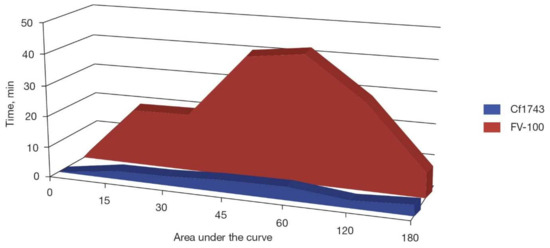
Figure 5.
Oral bioavailability of FV-100 as compared to Cf1743 as monitored by area under the curve (AUC) versus time. (Figure from Ref. [1]).
7. Clinical Evaluation
Three randomized double-blind, placebo-controlled clinical trials were conducted [20]. The overall conclusion of these clinical studies was that the pharmacokinetic and safety profiles of FV-100 justified further investigation for the treatment of herpes zoster and the prevention of postherpetic neuralgia (PHN) with once-daily oral dosing, i.e., 400 mg QD for 7 days, without modifications for the elderly or renally impaired patients [20].
The potential of FV-100 for the prevention of PHN and the treatment of acute herpes zoster-associated pain has been (again) emphasized in a randomized-controlled clinical trial [21]. The data presented by Tyring et al. point to the potential role for FV-100 in the reduction in subacute and chronic pain as well as the prevention of PHN. The safety profile of FV-100 remains favorable both in isolation and when compared to valacyclovir. Current antiviral medications have limited effectiveness in the reduction in subacute and chronic pain; they do not satisfactorily prevent or adequately treat PHN and require dosing modifications in patients with renal insufficiencies. The efficacy results from this study support further investigation of FV-100 to address these unmet medical needs [21].
8. Conclusions and Perspectives
FV-100 has been hailed [1] as the most potent and selective anti-VZV agent reported to date (2010). Yet, neither FV-100 nor its active ingredient, Cf1743 (Figure 1), are currently on the market as antiviral drugs. What is hampering their clinical development?
Of crucial importance is that the target of antiviral action for CF1743, i.e., the VZV DNA polymerase has been presumed but not unequivocally demonstrated. Additionally, direct evidence for the final conversion of the Cf1743 diphosphate to the triphosphate (presumably by the nucleoside diphosphate kinase (NDPK)) is still lacking.
That the esterification of Cf1743 by valine greatly increases its oral bioavailability is reminiscent of what is known for valacyclovir versus acyclovir) and valganciclovir versus ganciclovir), but how would other aminoacyl esters behave in this regard?
The major discomfort resulting from herpes zoster (shingles) is acute zoster-associated pain and post-herpetic neuralgia (PHN), but how would the efficiency of Cf1743 (or FV-100) compare in this respect with the efficiency of established treatments such as valacyclovir, famciclovir and BVDU? The topical delivery of Cf1743 was claimed to limit the extent and severity of PHN [22], but the topical treatment of herpes zoster is not routinely advocated in medical practice.
The conversion of CF1743 to phosphoramidate protides would seem most attractive to honor Prof. Chris McGuigan’s legacy, and deserves more attention, certainly in attempts to enhance oral bioavailability. For 2′-fluro derivatives of Cf1743 [23,24], the ProTide approach was determined to be not successful [23], but this conclusion was based solely on “not successful in bypassing VZV TK deficiency”. As demonstrated for tenofovir alafenamide [25], conjugation with a phosphoramidate moiety may greatly enhance the oral bioavailability.
News provided by Contravir Pharmaceuticals, Inc., on 03 March 2016 dealt with positive results confirming the safety of its shingles candidate FV-100 in a drug–drug interaction study [26]. The comparative study of FV-100 versus valacyclovir for the prevention of post-herpetic neuralgia was further documented in a report from the U.S. National Library of Medicine (ClinicalTrials.gov [27]). Contravir Pharmaceuticals then announced, on 22 July 2019, that their name had changed to Hepion Pharmaceuticals, Inc. [28]. None of these reports [26,27,28] mentioned any adverse effects encountered with FV-100.
9. Epilogue
This article does not attempt to provide a possible comparative evaluation of the market value of vaccination versus therapy in the management of varicella-zoster virus (VZV) infection. The aim of this article is primarily intended to assess the benefits of FV-100 in the treatment of VZV infections. By definition, it does not want to assess the potential benefit of any vaccination, because the latter approach is based on the prevention (prophylaxis) of VZV infections, whereas with FV-100 I wanted to highlight its potential in the therapy of VZV infections, including herpes zoster and the clinical symptoms (i.e., PHN) thereof.
Funding
This research received no external funding.
Institutional Review Board Statement
Not applicable.
Informed Consent Statement
Not applicable.
Data Availability Statement
Not applicable.
Acknowledgments
Dedicated to Graciela Andrei and Robert Snoeck; in memory of Christopher McGuigan. I thank Myriam Cornelis for her dedicated editorial assistance.
Conflicts of Interest
The author declares no conflict of interest.
References
- Migliore, M. FV-100: The most potent and selective anti-varicella zoster virus agent reported to date. Antivir. Chem. Chemother. 2010, 20, 107–115. [Google Scholar] [CrossRef] [PubMed]
- De Clercq, E. Highly potent and selective inhibition of varicella-zoster virus replication by bicyclic furo[2,3-d]pyrimidine nucleoside analogues. Med. Res. Rev. 2003, 23, 253–274. [Google Scholar] [CrossRef] [PubMed]
- De Clercq, E. Highly Potent and selective inhibition of varicella-zoster virus replication by bicyclic furo[2,3-d]pyrimidine nucleoside analogues (BCNAs). In Herpes Zoster; Gross, G., Doerr, H.W., Eds.; Recent Aspects of Diagnosis and Control; Karger: Basel, Switzerland, 2006; pp. 131–142. [Google Scholar]
- De Clercq, E. Emerging antiviral drugs. Expert Opin. Emerg. Drugs 2008, 13, 393–416. [Google Scholar] [CrossRef] [PubMed]
- De Clercq, E. A cutting-edge view on the current state of antiviral drug development. Med. Res. Rev. 2013, 33, 1249–1277. [Google Scholar] [CrossRef]
- De Clercq, E. Selective anti-herpesvirus agents. Antivir. Chem. Chemother. 2013, 23, 93–101. [Google Scholar] [CrossRef]
- De Clercq, E. An Odyssey in antiviral drug development-50 years at the Rega Institute: 1964–2014. Acta Pharm. Sin. B 2015, 5, 520–543. [Google Scholar] [CrossRef]
- Andrei, G.; Snoeck, R. Emerging drugs for varicella-zoster virus infections. Expert Opin. Emerg. Drugs 2011, 16, 507–535. [Google Scholar] [CrossRef]
- Andrei, G.; Snoeck, R. Advances in the treatment of varicella-zoster virus infections. Adv. Pharmacol. 2013, 67, 107–168. [Google Scholar] [CrossRef]
- Andrei, G.; Snoeck, R. Advances and perspectives in the management of Varicella-Zoster virus infections. Molecules 2021, 26, 1132. [Google Scholar] [CrossRef]
- Dropulic, L.K.; Cohen, J.I. Update on new antivirals under development for the treatment of double-stranded DNA virus infections. Clin. Pharmacol. Ther. 2010, 88, 610–619. [Google Scholar] [CrossRef]
- Price, N.B.; Prichard, M.N. Progress in the development of new therapies for herpesvirus infections. Curr. Opin. Virol. 2011, 1, 548–554. [Google Scholar] [CrossRef]
- De, S.K.; Hart, J.C.; Breuer, J. Herpes simplex virus and varicella zoster virus: Recent advances in therapy. Curr. Opin. Infect. Dis. 2015, 28, 589–595. [Google Scholar] [CrossRef]
- McGuigan, C.; Yarnold, C.J.; Jones, G.; Velázquez, S.; Barucki, H.; Brancale, A.; Andrei, G.; Snoeck, R.; De Clercq, E.; Balzarini, J. Potent and selective inhibition of varicella-zoster virus (VZV) by nucleoside analogues with an unusual bicyclic base. J. Med. Chem. 1999, 42, 4479–4484. [Google Scholar] [CrossRef]
- McGuigan, C.; Barucki, H.; Carangio, A.; Blewett, S.; Andrei, G.; Snoeck, R.; De Clercq, E.; Balzarini, J.; Erichsen, J.T. Highly potent and selective inhibition of varicella-zoster virus by bicyclic furopyrimidine nucleosides bearing an aryl side chain. J. Med. Chem. 2000, 43, 4993–4997. [Google Scholar] [CrossRef]
- Andrei, G.; Sienaert, R.; McGuigan, C.; De Clercq, E.; Balzarini, J.; Snoeck, R. Susceptibilities of several clinical varicella-zoster virus (VZV) isolates and drug-resistant VZV strains to bicyclic furano pyrimidine nucleosides. Antimicrob. Agents Chemother. 2005, 49, 1081–1086. [Google Scholar] [CrossRef]
- Balzarini, J.; Sienaert, R.; Liekens, S.; Van Kuilenburg, A.; Carangio, A.; Esnouf, R.; De Clercq, E.; McGuigan, C. Lack of susceptibility of bicyclic nucleoside analogs, highly potent inhibitors of varicella-zoster virus, to the catabolic action of thymidine phosphorylase and dihydropyrimidine dehydrogenase. Mol. Pharmacol. 2002, 61, 1140–1145. [Google Scholar] [CrossRef]
- Sienaert, R.; Naesens, L.; Brancale, A.; De Clercq, E.; McGuigan, C.; Balzarini, J. Specific recognition of the bicyclic pyrimidine nucleoside analogs, a new class of highly potent and selective inhibitors of varicella-zoster virus (VZV), by the VZV-encoded thymidine kinase. Mol. Pharmacol. 2002, 61, 249–254. [Google Scholar] [CrossRef]
- McGuigan, C.; Pathirana, R.N.; Migliore, M.; Adak, R.; Luoni, G.; Jones, A.T.; Díez-Torrubia, A.; Camarasa, M.J.; Velázquez, S.; Henson, G.; et al. Preclinical development of bicyclic nucleoside analogues as potent and selective inhibitors of varicella zoster virus. J. Antimicrob. Chemother. 2007, 60, 1316–1330. [Google Scholar] [CrossRef]
- Pentikis, H.S.; Matson, M.; Atiee, G.; Boehlecke, B.; Hutchins, J.T.; Patti, J.M.; Henson, G.W.; Morris, A. Pharmacokinetics and safety of FV-100, a novel oral anti-herpes zoster nucleoside analogue, administered in single and multiple doses to healthy young adult and elderly adult volunteers. Antimicrob. Agents Chemother. 2011, 55, 2847–2854. [Google Scholar] [CrossRef][Green Version]
- Tyring, S.K.; Lee, P.; Hill, G.T., Jr.; Silverfield, J.C.; Moore, A.Y.; Matkovits, T.; Sullivan-Bolyai, J. FV-100 versus valacyclovir for the prevention of post-herpetic neuralgia and the treatment of acute herpes zoster-associated pain: A randomized-controlled trial. J. Med. Virol. 2017, 89, 1255–1264. [Google Scholar] [CrossRef]
- Jarvis, C.A.; McGuigan, C.; Heard, C.M. In vitro delivery of novel, highly potent anti-varicella zoster virus nucleoside analogues to their target site in the skin. Pharm. Res. 2004, 21, 914–919. [Google Scholar] [CrossRef]
- Derudas, M.; Quintiliani, M.; Brancale, A.; Andrei, G.; Snoeck, R.; Balzarini, J.; McGuigan, C. Evaluation of novel phosphoramidate ProTides of the 2′-fluoro derivatives of a potent anti-varicella zoster virus bicyclic nucleoside analogue. Antivir. Chem. Chemother. 2010, 21, 15–31. [Google Scholar] [CrossRef][Green Version]
- McGuigan, C.; Derudas, M.; Quintiliani, M.; Andrei, G.; Snoeck, R.; Henson, G.; Balzarini, J. 2′-Fluorosugar analogues of the highly potent anti-varicella-zoster virus bicyclic nucleoside analogue (BCNA) Cf 1743. Bioorg. Med. Chem. Lett. 2009, 19, 6264–6267. [Google Scholar] [CrossRef]
- De Clercq, E. Role of tenofovir alafenamide (TAF) in the treatment and prophylaxis of HIV and HBV infections. Biochem. Pharmacol. 2018, 153, 2–11. [Google Scholar] [CrossRef]
- ContraVir Pharmaceuticals Reports Positive Results Confirming the Safety of its Shingles Candidate FV-100 in a Drug-Drug Interaction Study. Available online: https://www.prnewswire.com/news-releases/contravir-pharmaceuticals-reports-positive-results-confirming-the-safety-of-its-shingles-candidate-fv-100-in-a-drug-drug-interaction-study-300230016.html (accessed on 4 April 2022).
- A Comparative Study of FV-100, vs. Valacyclovir for the Prevention of Post-Herpetic Neuralgia. Available online: https://clinicaltrials.gov/ct2/show/results/NCT02412917 (accessed on 4 April 2022).
- ContraVir Pharmaceuticals Announces Name Change to Hepion Pharmaceuticals, Inc.; Trading Symbol Change to “HEPA”. Available online: https://www.globenewswire.com/news-release/2019/07/22/1885994/0/en/ContraVir-Pharmaceuticals-Announces-Name-Change-to-Hepion-Pharmaceuticals-Inc-Trading-Symbol-Change-to-HEPA.html (accessed on 4 April 2022).
Publisher’s Note: MDPI stays neutral with regard to jurisdictional claims in published maps and institutional affiliations. |
© 2022 by the author. Licensee MDPI, Basel, Switzerland. This article is an open access article distributed under the terms and conditions of the Creative Commons Attribution (CC BY) license (https://creativecommons.org/licenses/by/4.0/).
